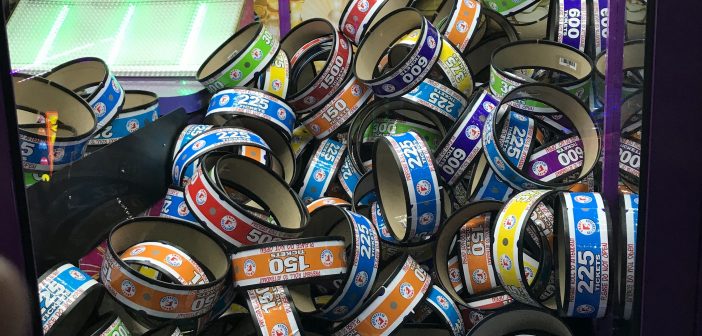Put a Ring IN it!
Smart’s Ticket Crane Craze Hikes It Up a Big Notch with Ticket Rings
Sometimes, you’ll find that the person with the original idea doesn’t really hit it out of the park, and that it’s someone looking from the outside, seeing the potential, who smacks the grand slam. This might be the best way to describe what Smart Industries has done, first with its Ticket Time crane and now with its Taj Mahal giant crane and Ticket Ring cranes.
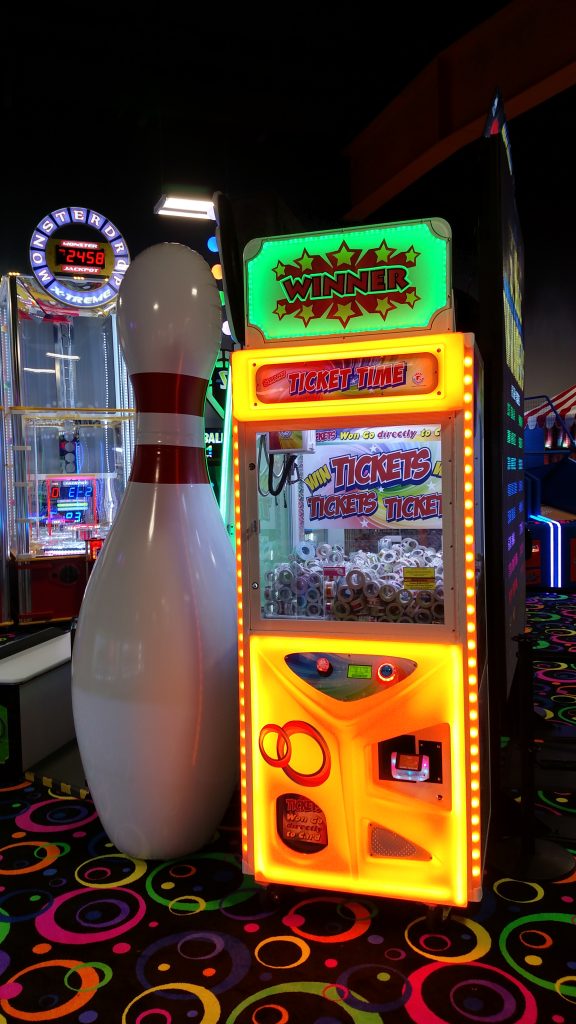 As Sales VP Jim Dupree explained of the original concept, which debuted in the fall of 2015, the Ticket Time crane built upon an idea they’d seen in Europe. Instead of maneuvering the claw over to win a stuffed animal or other prize, players tried to win rolls of tickets of varying amounts (the standard mix includes bundles from 25 to 500 tickets).
As Sales VP Jim Dupree explained of the original concept, which debuted in the fall of 2015, the Ticket Time crane built upon an idea they’d seen in Europe. Instead of maneuvering the claw over to win a stuffed animal or other prize, players tried to win rolls of tickets of varying amounts (the standard mix includes bundles from 25 to 500 tickets).
“The first time I saw it was in 2006 or so in England, and what’s worth noting is how we’ve extended that profile into what’s become a major powerhouse,” Dupree said. “We brought it to the forefront of the industry and helped operators understand how to make money with it.”
Dupree explained that it took a few years in the States for operators to realize the benefits. Some had already been putting bundles of tickets in cranes and other machines like Sports Arena and Lighthouse, but it wasn’t a prevalent practice. Collaborating with Tennessee operator Clarence Mabe of FACE, Smart Industries owner Jeff Smart got his team together to develop a crane they felt would be successful: Ticket Time.
“When we put it in the marketplace, the result was sensational. I can’t tell you how many people tell me this is the best game ever made. I’ve never seen anything like it. One old guy in Mississippi called and told me, ‘I was about to call it a day, but I’ll tell you something, I got your Ticket Time and it gave me new hope,’” Dupree recounted.
Quick to read some “if it’s sounds too good to be true…” skepticism, Dupree interjected, “This isn’t hype, it’s fact. We literally developed one of the best amusement pieces for the player, ever. I’m not saying it’s the best game ever made, but people have told us that.
“It’s a unique piece and definitely has a special place in recent amusement industry history,” he said. “We took an idea that people around the world were already trying and brought it out in a package that can be used on every level of the industry. We’ve created a product that provides a satisfaction level that is exactly what players come to an entertainment center for. It’s nothing less that spectacular.”
Making a Good Thing Even Better
About a year and a half ago, the Smart team took the original coin-in/prize out (ticket rolls) version of the game to another level, adding RFID. With the original game, players would get the ticket bundles and then take them to the prize counter for redemption. The company’s patent- and copyright-protected Ticket-Smarts RFID system reduces that labor, as well as the cost of the rolls, by keeping the rolls in the crane. It’s the same game, but when the location adds a swipe card system to the machine, it becomes a non-dispensing unit. (Even if a player grabs multiple bundles in one attempt, the crane is able to accurately count them all.)
“Satisfaction remained high because the player sees the win. When they grab it and see it drop, they have to know they won, even though they don’t physically get the ticket roll,” said Dupree.
Clarence Mabe said Ticket Time, especially the RFID model, “was probably one of the smartest moves that’s ever been made in our industry. I’ll tell you why,” he said. “Everybody has a crane, but to take something everyone has and repackage it and for it to be so popular, is special.”
Today, Ticket Time comes in both ticket roll-dispensing and RFID models in three sizes: a 31” single, 45” single (the RFID model is brand new) and a 61” double. (Dupree said the doubles do really well if the operator has the space for it.
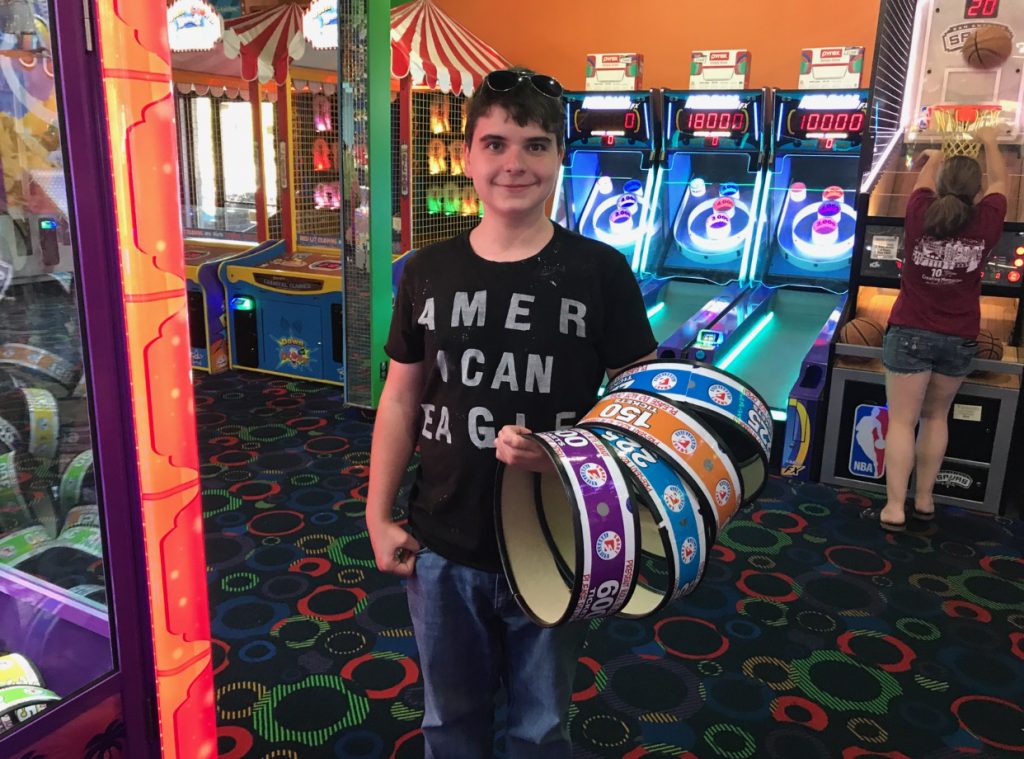
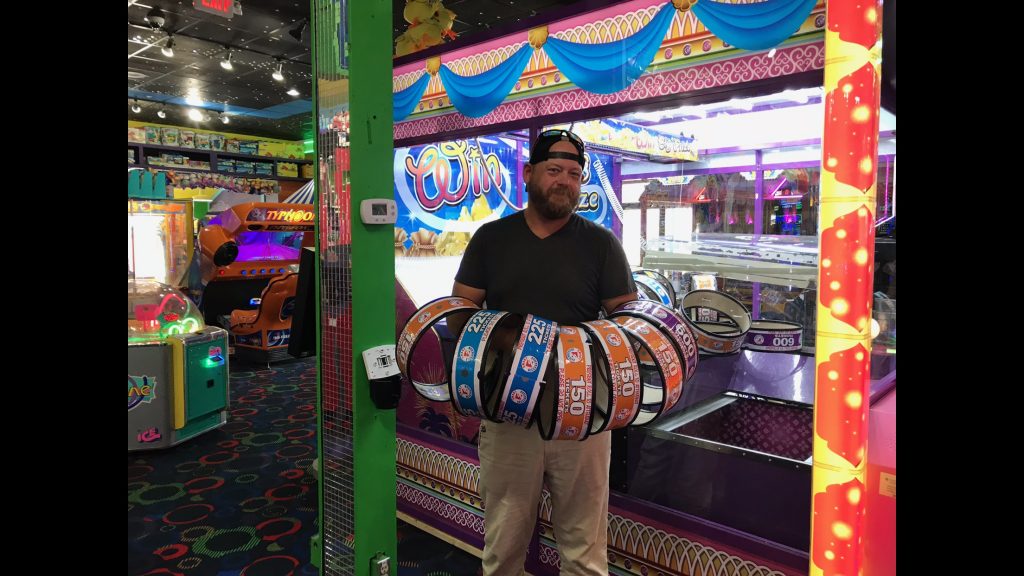
Winning looks good on you … and you … and you! Players seem to love wandering around the game room wearing the prize rings from the Smart Taj Mahal crane.
Cranking It Up
In the spring of 2017, Jeff Smart had the idea of creating a bigger prize that would take the Ticket Time feeling to a larger scale. The company created its Taj Mahal-themed giant crane using 12” rings (patent pending) with varying ticket values as prizes.
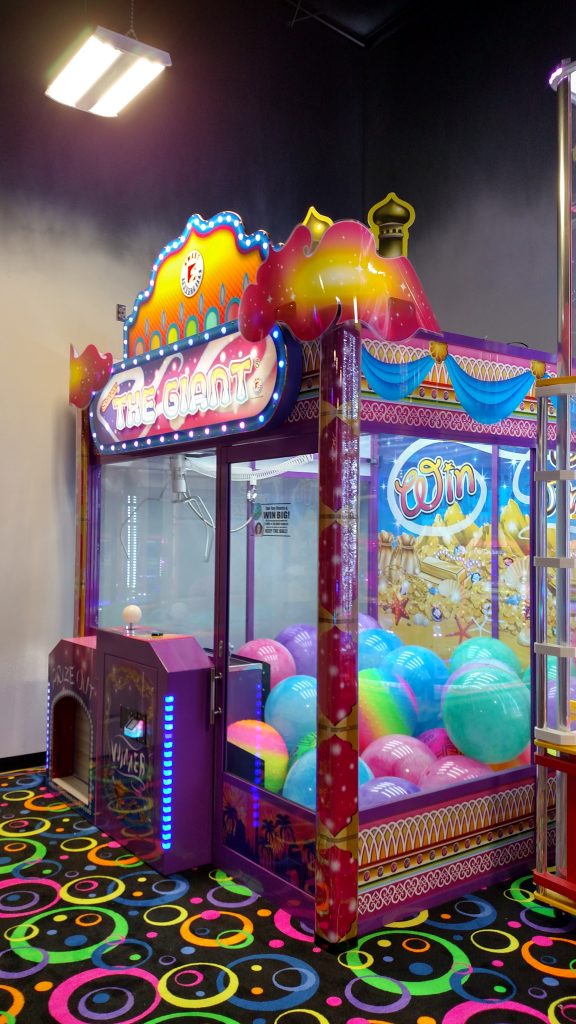 Dupree remembered, “We took that to the Amusement Expo and when we were done, that game was sent to one of Clarence Mabe’s locations in Tennessee. The result was beyond all expectations for any single player game out there. In six months, it grossed $160,000. As if Ticket Time wasn’t already great, Taj Mahal took it to the next level.”
Dupree remembered, “We took that to the Amusement Expo and when we were done, that game was sent to one of Clarence Mabe’s locations in Tennessee. The result was beyond all expectations for any single player game out there. In six months, it grossed $160,000. As if Ticket Time wasn’t already great, Taj Mahal took it to the next level.”
“We charge $3 per play and had never been able to do that before we got a card system,” Mabe said, adding that they now charge $5 per play on LAI’s Virtual Rabbids. “If not for the Embed card system, I couldn’t do it. No one’s going to put in 12 quarters or feed in three one-dollar bills. Using the card system has improved our gameroom revenue big time. The man-hours it’s saved have been big for us.”
Mabe says the players walking around with giant rings have been big for them, too. He said they collect them at the redemption counter and load them onto a pole. The result resembles a totem pole, he said, as it fills up before staff takes them back to the Taj Mahal. “They advertise themselves,” he said.
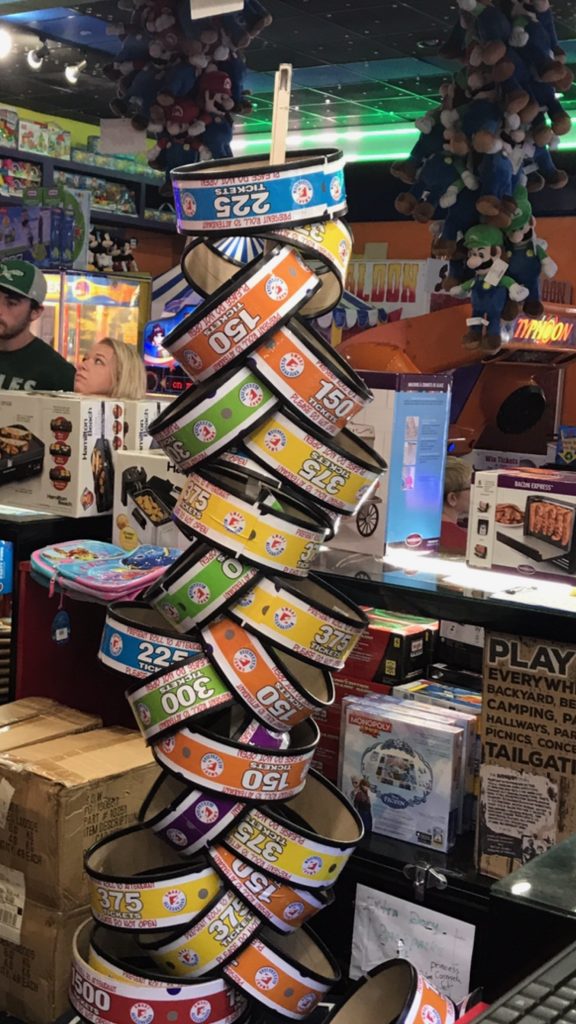 Mabe continued: “First of all, you have to know why people play a crane and that’s because they get to see something in there of value. Second, they have to perceive that they can win it. Third is that winners make players. Put those three together and you’ve got a winner. With Taj Mahal, they see value in the prize rings, feel like they truly can win and actually they do win. Winning is just as important as the value they win; it’s still gratification whether you win 20 points vs. 200. Operators mess up when they don’t follow those three rules.”
Mabe continued: “First of all, you have to know why people play a crane and that’s because they get to see something in there of value. Second, they have to perceive that they can win it. Third is that winners make players. Put those three together and you’ve got a winner. With Taj Mahal, they see value in the prize rings, feel like they truly can win and actually they do win. Winning is just as important as the value they win; it’s still gratification whether you win 20 points vs. 200. Operators mess up when they don’t follow those three rules.”
Taj Mahal’s Little Brother
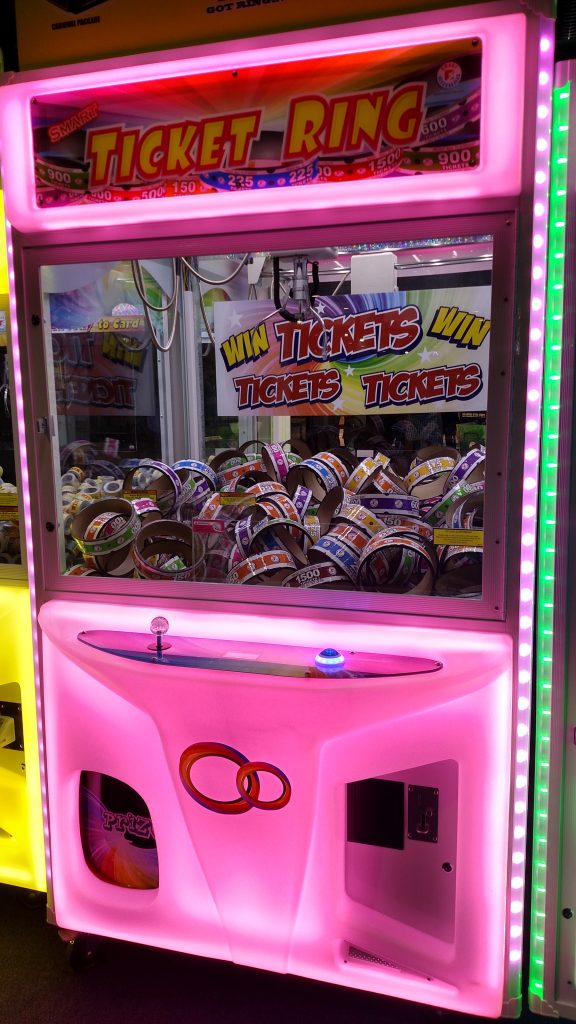 Knowing full well that a lot of fun centers don’t have the 9’ x 8’ footprint needed for The Giant Taj Mahal, the development team went back to work and in November 2017, debuted Ticket Ring, a smaller-scale version that uses smaller prize rings. In two sizes – the Narrow at 45” wide x 33” deep and the Wide at 45” wide x 44” deep – the factory feels they now have a way for everyone to cash in on ticket ring mania. Dupree adds they work well together, claiming that The Giant Taj Mahal or a Ticket Ring game and a Ticket Time do not pull from each other in the same location.
Knowing full well that a lot of fun centers don’t have the 9’ x 8’ footprint needed for The Giant Taj Mahal, the development team went back to work and in November 2017, debuted Ticket Ring, a smaller-scale version that uses smaller prize rings. In two sizes – the Narrow at 45” wide x 33” deep and the Wide at 45” wide x 44” deep – the factory feels they now have a way for everyone to cash in on ticket ring mania. Dupree adds they work well together, claiming that The Giant Taj Mahal or a Ticket Ring game and a Ticket Time do not pull from each other in the same location.
“What we’ve done is something no less than remarkable,” Dupree said. “There are three different-sized rings that we’re using in our machines and they make more money than anything else out there. I’m not exaggerating when I tell you that they are the most profitable games in the business.”
Talking to operator Jimmy Waldorf of Fun Plaza in Myrtle Beach, S.C., you get a sense that Dupree is right on the money. “I have a pretty good-sized arcade,” said Waldorf, understating things a good bit (after all, he has 280 games). “I got Ticket Ring on April 30 and it’s been probably in the top two consistently ever since.”
He continued, “The machine stated out big and it’s humongous now.” Putting it in during the lull after Easter, it made $806 the first week. “I thought, ‘BOOM!’ This is one of those machines we have to keep our eyes on. Oh man, it’s amazing.” Now in the heat of their season, Waldorf said it’s averaged about $2,800 a week the last five weeks.
“I’m curious to see what it will do in the off season,” he said, noting that unlike some seaside locations, he gets good year-round business.
Perhaps best known for his extensive collection of 1957 Williams Baseball games (he has 30 in one line and eight more in another), Waldorf also boasts that he’s a crane person, but had not been a believer in ticket cranes.
“I kept saying, ‘Nope, I’m not doing it.’ Everyone around says they are making big money, but I didn’t believe it and didn’t do it,” he said. “I told my distributor, Player One Amusement Group, ‘If you want me to try a ticket crane, you’ve got to bring it down here and shove it in my door…and they did.
“Now, I don’t have much room in my arcade to put new pieces in and a new game means I have to pull something else out, but I found a spot for it back in a corner near some other cranes that weren’t performing well and two Coke machines. I thought, well it looks nice and it’s well lit so it might draw players. Well, it boosted those five cranes and the Coke machines like crazy. Now, those two Coke machines are the two best performing Coke machines we have in the place!”
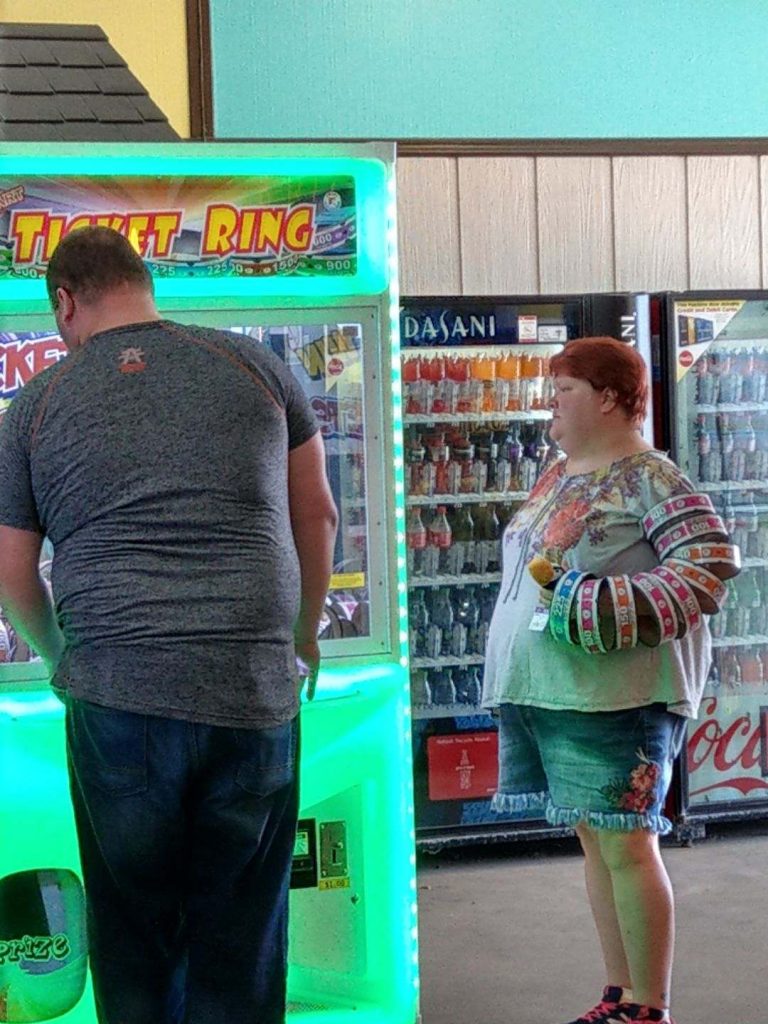 Waldorf doesn’t run the RFID version of Ticket Ring, but doesn’t mind the little bit of extra labor he has having to return them to the machines every morning.
Waldorf doesn’t run the RFID version of Ticket Ring, but doesn’t mind the little bit of extra labor he has having to return them to the machines every morning.
“People win the rings and put them on their arms, legs and head and walk around with them before finally turning them into the prize counter. My attendants just pile them up in the corner of the prize booth. The next morning, I count out how many rings and point values so I can track if I’m still doing well and then an employee just gathers them up and puts them back into the machine.”
Working in the business since he was 8, the 57-year-old Waldorf certainly knows a winner when he sees it. He concluded, “I can say that except for a little bit of extra work – counting the rings – they sure sold me on a ticket crane. It’s just amazing. I always figured players wanted to play for a prize and instant win. The ring is not really an ‘instant win,’ but it must feel the same to the players.”
Dealers Dig ’Em, Too
Rick Kirby, Betson New England Distributing’s Divisional Exec VP and Managing Director, said, “The ticket industry has revolutionized the amusement business, it really has. From guys putting bundles of tickets in cranes years ago to Smart coming out with Ticket Time and then their RFID Ticket Time, it’s ticket mania! Everyone is ticket crazy and Smart has taken it to the next level.”
Kirby continued, “Operators are making incredible money with these cranes. Now with RFID, the tickets don’t really ever ‘leave the machine,’ if you will. The operator just has to dump the bucket of tickets back in.
“What’s important about these ticket cranes is that they’re giving the players what they want. It’s almost like instant gratification when they win the bundle. And the rings, what a great idea! I know it didn’t originate with Smart – they saw the concept overseas – but they certainly took it to the next level.”
When it comes to generating player excitement, Kirby recalled, “There is nothing better than a kid or patron walking around a location with an armful of rings. We always used to say there was nothing better than when we saw a kid walking around with string of tickets in his hand and with a big smile on his face. Now it’s the same with people and walking around with these rings.”
Kirby says Taj Mahal is a “WOW” piece. “It’s different than anything we’ve ever had,” he said. “Honestly, it’s an operator’s dream. Let me give you an example of the game’s appeal. There was an association meeting up in Maine at a small amusement park that had a Taj Mahal. One of my customers – a guy who owns a bigger amusement park – saw it and ordered three!
“People see a game like that and get excited and that’s not a bad thing! I tell you, Smart has done a really, really good job. They always have, but over the last year or so, all I can say is wow! Smart is doing really well and they deserve it. Everybody is making money with Smart,” he said. “And their equipment is priced fairly. This may not be true in all places, but in some locations, an operator can buy a 31” Ticket Time with RFID and have it paid for in two or three months. C’mon…what’s wrong with that?! You can’t beat that kind of ROI.”
What’s Next
Today, the factory is making a significant global push with the cranes. In addition to finding the Smart ticket and ring machines in fun centers across the U.S., Jeff Smart says they are also selling well in the U.K. (where the factory works with Sega Europe), Dubai, UAE, Australia, Turkey, Canada and New Zealand. (Dupree noted that their games are patented in multiple countries.)
Dupree also noted that development is ongoing. “We’ve enjoyed a tremendous amount of success with this piece and want to explore all potential with it. It will continue to evolve and you may see some surprises on the horizon as we get feedback from operators around the world. It’s been an evolution from the start of this thing and we’re still going!” Dupree said.
“The ring effort has been nothing less than remarkable,” said Jeff Smart. “Once in a while, the winds blow your way and you land a winner. We’re proud to have Ticket Time, Ticket Ring and the Taj Mahal rings, which have definitely pushed our internal efforts.”
Smart said the success is welcome and that they’ve added staff in production to keep up with demand. “It’s great to hear reports about the strong earnings of the games from distributors and FEC owners, which have been constant since we introduced Ticket Time in 2015. So, where do we go from here? Fortunately, we’ve been able to create new avenues for the rings that don’t compete with Ticket Time. We find that both games together on the same floor are successful and shine at the top in the location reports.
“If we can take this in new directions that continue to have success, we definitely will. Who knows what IAAPA will bring,” Jeff Smart hinted.
For more information, visit your local Smart distributor or the factory online at www.smartind.com. (Readers can watch detailed videos of the company’s games on that site in the “Video Center” at www. smartind.com/videos.

